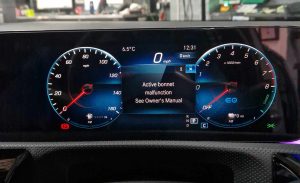Active Bonnet Malfunction
Some of Mercedes’ smartest safety tech is hidden where you’d least expect it — inside the bonnet hinges. The Active Bonnet system is designed to react in a split second, lifting the bonnet to create crucial space that helps reduce injury if a pedestrian is struck. It’s clever engineering you’ll hopefully never need, but it’s reassuring to know it’s always ready.
When a Mercedes A-Class came into Smith’s of London in Croydon with an Active Bonnet Malfunction warning, it needed more than a quick reset. Our technicians relied on Mercedes expertise, systematic diagnostics, and dealer-level tools to locate the fault with precision and deliver a first-time fix. No trial and error, no unnecessary costs — just a safe, accurate repair.
This is how we traced the cause, confirmed the diagnosis, and returned the A-Class to full pedestrian safety readiness, giving the customer confidence that the system would respond instantly if ever called upon.

Mercedes Active Bonnet Technology: What You Need to Know
The Active Bonnet system is an advanced Mercedes safety feature created to help reduce injury risk to pedestrians if a collision occurs. At the rear bonnet hinges sit pyrotechnic lifters that, when triggered, raise the back of the bonnet by roughly 80 mm in just milliseconds. This sudden lift creates a gap between the bonnet panel and the rigid engine parts beneath, giving crucial space to absorb impact energy and minimise harm.
The system is managed by the car’s Supplemental Restraint System (SRS) control unit, which works with crash sensors located in the front bumper. Each hinge is fitted with its own lifter, and when deployed, the bonnet stays partially raised until reset. While it can be pushed down again so the car remains driveable, the protective capability is lost until the issue is resolved and the system is reinstated by a professional.
Active Bonnet Malfunction: The First Diagnostic Stage
When the Mercedes A-Class came into Smith’s of London in Croydon, the owner was concerned about the dashboard message: “Active Bonnet Malfunction – see owner’s manual.” This is never a warning to brush aside. If the system isn’t active, the added pedestrian protection it provides won’t engage when it’s most needed.

Our technicians connected our Mercedes dealer-level diagnostic equipment to the car and ran a full scan. Using the same system as the dealerships ensures we access manufacturer data and guided test routines without limitation. The scan revealed a stored code: B2730 – Left Rear Engine Hood Lifter Squib Malfunction. Basically, the control unit had logged an issue with the squib, the small pyrotechnic lifter that raises the bonnet during a collision.
This was enough to tell us where the system had seen a fault, but not the underlying reason. Fault codes point to the area affected, but they don’t explain the cause. To get the full picture, our team followed a structured diagnostic routine, testing serial data, wiring, connectors, and linked modules to establish the true point of failure and rule out other hidden faults.
Tracing Fault Code B2730 to Its Source
After completing the initial scan, our next step was a detailed investigation. At Smith’s of London in Croydon, that meant drawing on our Mercedes expertise, using our structured diagnostic evaluative process and the same dealer-level technical data and equipment trusted by main dealers.
We started by consulting Mercedes-Benz’s official documentation for Fault Code B2730, which confirmed the code pointed to the squib circuit for the left bonnet lifter. Our task wasn’t just to note the fault but to understand why the system had detected it.
To narrow it down, we compared serial data from both bonnet lifter circuits. The right-hand lifter showed a normal signal, while the left produced no measurable reading at all — an indicator of an open circuit. Comparing the two sides is essential; with the healthy circuit as a reference, we could be sure the fault was real and isolated.
We then carried out physical inspections of the wiring harness and connectors linked to the left lifter. No signs of corrosion or damage were found, and continuity and resistance checks confirmed the wiring was performing as it should. With the wiring eliminated as the cause, the evidence pointed directly at the lifter itself.
Consistent test results confirmed the left-hand squib had failed internally. By following this structured approach, we avoided replacing good parts unnecessarily and ensured the exact source of the fault was identified, ready for a precise repair.
Repairing Fault Code B2730 in the Active Bonnet System
Once the fault was confirmed, we contacted the customer to explain exactly what we had found and how the repair would be carried out. With safety systems like the Active Bonnet, it’s important to be clear and thorough. After receiving approval, we followed Mercedes-Benz’s safety procedures for working with pyrotechnic devices, disconnecting the battery and allowing the system to discharge fully before removing the faulty left-hand lifter.
The new component was then installed and tightened to the correct torque settings to ensure accurate alignment and secure fitment. We compared the signals from both bonnet lifter circuits to confirm consistency, a crucial step to prevent the control unit from logging another error and disabling the system.
Finally, we ran a comprehensive post-repair check. This included clearing the B2730 code, confirming through serial data that the Active Bonnet was fully functional, and ensuring no linked faults were present. With every check passed, the A-Class was returned to its owner with pedestrian protection restored to full readiness.
Mercedes Pedestrian Safety Restored After Fault Code B2730
With the repair complete, this Mercedes A-Class left Smith’s of London in Croydon with the Active Bonnet malfunction cleared and the system fully operational again. The car’s pedestrian safety technology was reinstated, ready to respond instantly in an emergency.
By identifying the precise cause and replacing only the faulty component, our technicians delivered a focused, cost-effective repair. Using dealer-level data, structured testing, and Mercedes know-how, we restored the system to the manufacturer’s standards on the first attempt.
For the customer, the benefit wasn’t just the disappearance of the dashboard alert. It was the peace of mind that their Mercedes’ safety features would now work as intended — providing critical protection in the moments when it matters most.
Your Mercedes Safety in Expert Hands at Smith’s of London
Seeing an Active Bonnet Malfunction warning on your dashboard isn’t something to ignore. The Active Bonnet system plays a vital role in pedestrian protection, and if it’s not working, it won’t activate in an emergency. If your Mercedes is showing a fault, call the specialists at Smith’s of London in Croydon on 020 8674 3377.
Our technicians follow a proven, step-by-step diagnostic process, supported by dealer-level tools and Mercedes technical data, to pinpoint faults with precision and fix them right the first time.
Why drivers in Croydon, Beckenham and Coulsdon trust Smith’s of London:
- 12-month parts and labour guarantee
- Dealer-level knowledge without main dealer costs
- Technical expertise in Mercedes safety systems
We’re proud to have earned a {{average-rating}} star Google rating from {{review-count}} satisfied customers.
Don’t compromise on safety. Call 020 8674 3377 today to book a diagnostic evaluation and get your Mercedes back to full protection.



